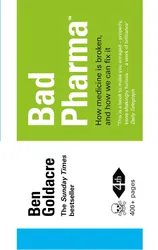This book, by the author of Bad Science, takes an in-depth look at the pharmaceutical industry. It covers many different ways in which the pursuit of profits gets in the way of good science, accurate information for doctors, and good healthcare for patients.
Some of the early topics will be familiar to readers of Bad Science and Science Fictions, as they cover more general ways in which science is done badly. These topics include published papers which are biased towards positive results, and a culture of scientific publishing which isn’t interested in negative results. They also include some of the more subtle ways that trials can be manipulated, such as by cutting them short once a desirable result has (by chance) been achieved, or extending them if the results aren’t so favourable. There are ways to make drugs look more beneficial (or have fewer side effects), such as by selecting healthier volunteers than those who will typically end up taking the drug, comparing a drug with unusual doses of a competing drug, or comparing a new drug with a placebo instead of the best available current treatment.
As well as the scientific side, the book covers areas like how regulators fail to enforce good practice on the pharmaceutical industry, and how ongoing education for doctors (often funded by the drug companies themselves) fails to keep them accurately and impartially informed about the best treatments. Then there are the drug reps, and the marketing activities, all designed to sell one company’s drug over a competitor’s. Where it’s possible to confuse or ignore the actual scientific data in order to sell more drugs, it seems these companies will do so.
The writing is at times sarcastic and withering, and Goldacre uses humour to lighten the mood of what is quite a depressing topic. This makes it entertaining to read, despite parts of it making me angry! Goldacre does highlight some positives, such as the work of organisations like Cochrane, who attempt to produce unbiased reviews of the evidence for drugs and other healthcare interventions. He also has a list of suggestions for how to fix the problems he’s discussed. Even so, this seems like a frustratingly difficult problem to solve, with the pharmaceutical companies having deep pockets and a vested interest in keeping things as they are. Some of the most frustrating parts of the book to read are where a problem has been identified and a solution implemented (such as pre-registering trials, to avoid negative results being quietly discarded) and then not enforced or maintained.
If you are taking any prescription drugs, this book may alarm you somewhat. Perhaps the confidence your doctor had in the benefits of those drugs was misplaced. So this is not a happy book to read! Despite being published in 2012, I have no reason to think that things have dramatically changed or improved since this book was first published. I think this book is still really important and eye-opening and well worth reading.
